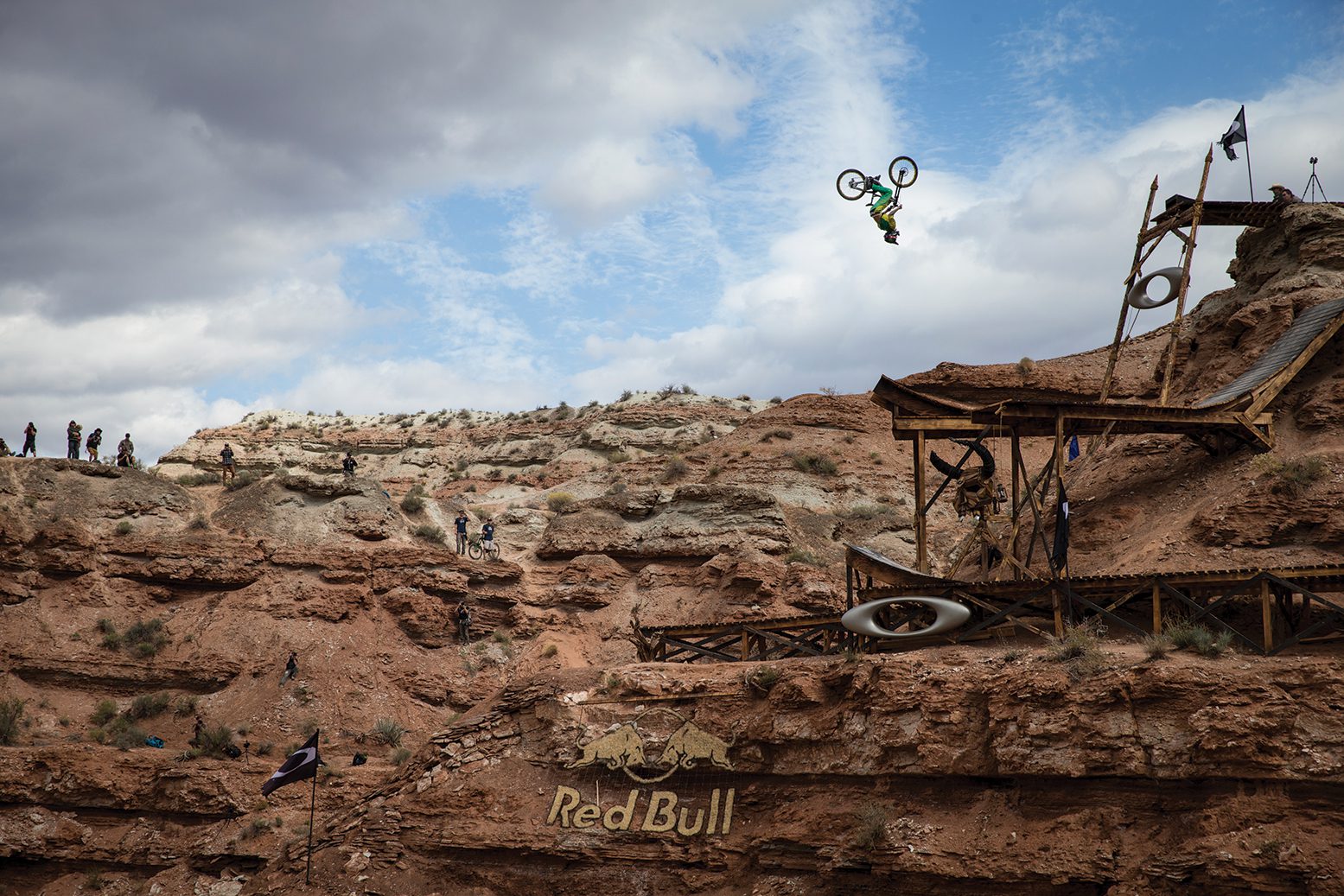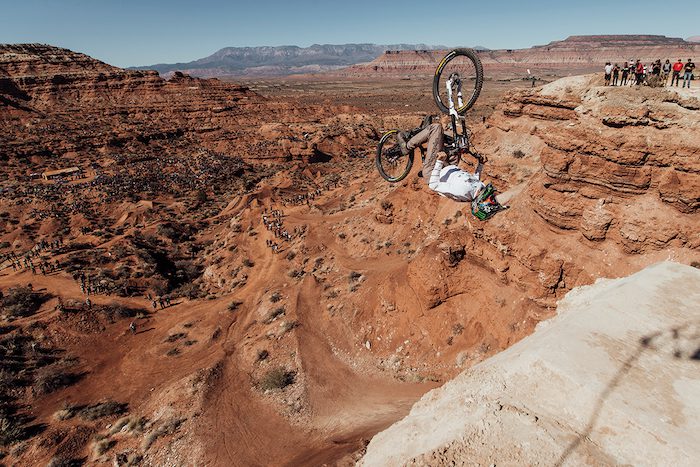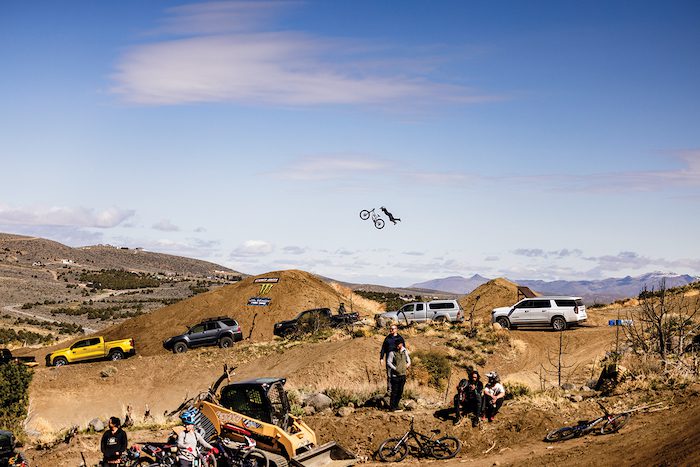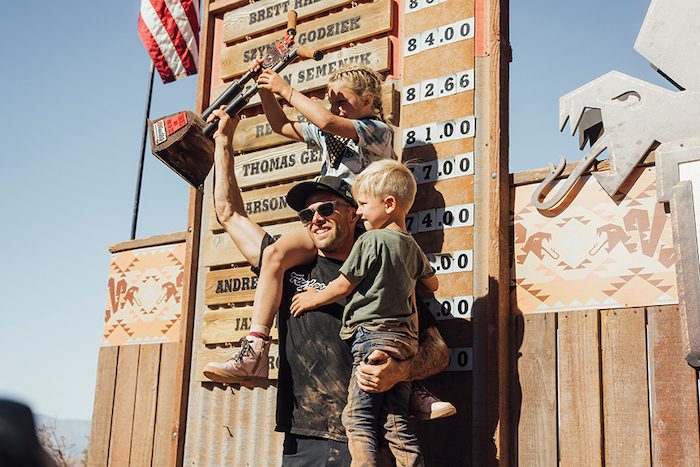
27 Sep The High-Flying Legacy of Cam Zink
Through his evolution from boundary-pushing pioneer to elder statesman, the Northern Nevada native continues to propel the sport of freeride mountain biking with his talents and mentorship
Cam Zink waits at the edge of the cliff, bike ready, helmet strapped. Storm clouds gather along the horizon, nearly eye-level from the top of the fin 1,500 feet above the desert floor. Spectators dot the landscape below.
Three years prior, in this same godforsaken patch of Virgin, Utah, Zink enshrined his legacy in freeride mountain biking when he threw a record-setting 360 spin, connecting the wooden ramp of the Oakley Icon Jump with the hard trail 40 feet below. It was a sport-defining jump that many of his peers still cite as their favorite moment in the storied history of Red Bull Rampage, a jump that earned him first place, “Best Trick” and, perhaps greatest of all, the rarefied distinction as one of the gutsiest high-flyers in a sport with no shortage of them.
But that was three years ago. Waiting at the edge of this cliff, Zink is both older and weaker. On a recent training ride in the Pine Nut Mountains near Carson City, he crashed into a tree, clipped his femoral artery and watched his thigh and groin swell with internal bleeding. Only the thickness of his padded shorts prevented an open wound, from which he’d have likely bled out on the long journey to the hospital.
He is stable, but the wound is infected. The doctors say it needs to be cut open and treated, but doing so would prevent him from competing in this year’s Rampage, right here on the knife’s edge, staring down what looks like a sheer vertical drop, hoping to land a monster backflip and cement his status as one of the finest athletes in history ever to ride a bike down a mountain.
Zink’s girlfriend waits at the bottom, days away from delivering their first child, a girl. He needs the money, not an easy resource in this niche sport filled with young daredevils whose numbers and appetites for danger seem to grow every year. He pushes off, slows, balances on the edge, and drops into the wall of the cliff.
For the next 30 seconds, Zink flows through a technical series of descents and traverses, half the mountain already behind him. The Red Bull commentators struggle to remain present as they prepare for his second attempt to make history.
“Trying to keep his composure as he knows the biggest part of his run is to come,” the first says, followed by his colleague breathlessly announcing, “Lots of speed for Cam Zink—he needs it!”
At the base of the high-speed descent, the trail levels out for a short transition before ending in a wooden ramp built on stilts out of the hillside. As Zink approaches the runway, the commentators fall silent. He reaches the terminus of the ramp, pulls back hard on his handlebars and begins his flip.
“Cam Zink upside down!” a stunned announcer belatedly shouts just as Zink’s two wheels touch down in perfect unison for the runout. All professional decorum is lost as the two men on mic release a verbal stream of disbelief over the historic 78-foot backflip. Out of the bedlam, one can be heard shouting, “Cam Zink just landed the biggest stepdown backflip in two-wheeled history! The doors have just been shattered on what can be done on a mountain bike!”
That flip was in 2013 and Cam Zink, now 38 years old, continues to stun announcers and shatter the doors of what can be done on a mountain bike. During the 2023 Red Bull Rampage, Zink recreated his iconic moment by landing a 63-foot stepdown backflip in the middle of a nearly perfect 95-point run.
“That’s so sick that he just did that,” the young announcer exclaimed, sounding less like a TV commentator and more like a fan watching his hero bust through the ceiling of possibility in real time. Zink, the oldest rider at Rampage, took home his second title.
“I didn’t fathom I’d still be doing this at 38,” Zink says, speaking by phone from his home in Hawaii. “I’m always trying to live up to my potential and I’m fortunate that it’s still the sport’s potential. That’s why I’m still in it and why I still enjoy it. I just keep trying to push the sport.”
Born to Ride
Growing up in Northern Nevada, Zink gravitated toward biking around Carson City, Reno and Tahoe at an early age, developing his appetite for adrenaline on his favorite local (and long-since-closed) trails like King’s, Axle’s and Jackie Chan off Kingsbury Grade. When he wasn’t riding established trails, he was building his own around “The Snake” in southeast Carson.
“A bike is your first form of freedom,” he says. “I rode my bike every day looking for new jumps, new stairs, new skate parks. That was always the main goal.”
It was clear from a young age that Zink’s passion for biking was more than a boyhood hobby, but few professional outlets existed in the early 1990s for his style of riding. The only obvious path led to racing on the national circuit, where the Carson High grad quickly emerged as one of the best juniors in the country. Despite his early success, it still wasn’t a perfect fit.

Zink competes in the 2021 Red Bull Rampage, photo by Bartek Wolinski / Red Bull Content Pool
Anyone can recognize the need for growth during failure, but the ability to recognize it as one of the best young racers in the country is no easy epiphany. Especially when growth means stepping away from an established path and starting over in a renegade offshoot of an already underappreciated and underfunded sport.
“What we’re doing now didn’t really exist,” Zink says of the discipline within downhill mountain biking known broadly as freeride. “I came in at a really special time. Every sport has its upswing where you’re able to help shape it and leave your mark on it. I was fortunate to be born at that time and help shape it as best as I could.”
Freeriding appealed to his natural strengths as a rider and fueled his aspirations as a professional athlete. It also saved him from the grueling transition to professional racing, a competitive discipline saturated with the world’s best racers.
“It was less about time training on a road bike and more about creativity and swinging for the fences,” he says. “It just turned out I was better at freeriding than racing. I was always one of the best juniors in the country, but if freeriding wasn’t there, I might not have made a career out of being a professional racer.
“I raced my last World Cup when I was 20,” he adds. “I never looked back.”
Pursuit of Freedom
The same hunger that made Zink walk away from a promising career in downhill racing animates him still, more than two decades into his unlikely career. There are few major decisions in his life untouched by the quest for the purest distillation of personal freedom, both on and off the bike, as a rider and an entrepreneur.
In 2010, in bed recovering from one of his many knee surgeries, Zink reflected on how hard it was to find handlebar grips that met his needs, and wondered what he could do to change that.
“Grips were the one thing I kept buying and trying, and I never found what I liked,” he says. “I had a lot of time on my hands and decided to make my own.”
Today, Zink and his brother run Sensus, a company that makes grips, seats, pedals, helmet bags, apparel and other accessories. They sponsor some of his best friends, who also happen to be the best riders in the world.
“I always looked up to business owners and those making their own destiny,” Zink says. “I don’t think I’m ever going to make a better tire than Michelin, or a better goggle than Oakley, but the things I think I can make better—that’s the fun and freedom. I wouldn’t be doing this if I didn’t think I could make something better for what I want.”
What began with a simple grip design in 2010 has continued into the quest for the perfect freeride bike frame, which Zink is in the process of finalizing heading into the 2024 Red Bull Rampage in October.
“I’ll be on my own bikes at Rampage, and I’ve been on them all year,” he says. “This is the first year of me not having a frame sponsor, which is usually the bulk of our income. With a wife and two kids that I support, it was very scary, but it’s also scary thinking about not performing well and losing that sponsor anyway. So, to formulate my destiny is better in the long run.”
Bringing the Trails to the People
Zink’s destiny extends beyond himself and has expanded to include the entire mountain biking community around Tahoe and beyond. As part of his Sensus brand, he has launched R.A.D. Trails, a 501C (3) nonprofit, to help build and improve trails for riders of all abilities. Most memorably, he and his team built a flow trail in the upper section of the Tyrolean Trail above Incline Village.
“It’s pretty special because it’s close to home and one of my favorite trails,” Zink says. “Tyrolean is the best public legal trail in Tahoe.”
Cody Wilkins, a mountain biker and trail builder from upstate New York, was part of the crew that worked on Tyrolean, in partnership with the Forest Service and Tahoe Area Mountain Biking Association (TAMBA). Today, he manages operations for Sensus R.A.D. Trails.
“Big jumps are starting to pop up at resorts,” Wilkins says, taking a short break from digging a flow trail at Jackson Hole that will ultimately connect to a jump line his team built last year. “We’re building bigger bike park jumps you don’t normally see in the lower 48.”
Sensus R.A.D. Trails also developed the jump park at Northstar, working from an old line Zink used to ride with friend and fellow freeride legend Kyle Strait—a line that needed some reworking to accommodate the general populace.
“A big part of my job is taking Cam’s vision and making it rideable for the public,” Wilkins says with a chuckle. “It’s a cool challenge: How do we bring the sickest stuff and scale it appropriately?”
Wilkins’ brother Henry was part of the Northstar build and sees firsthand the public reaction as people get to experience the kinds of trails and jumps—in spirit, if not actual distance and difficulty—that Zink himself made famous.
“We hear from people all the time who never thought they could hit jumps of those sizes, but we built them to be comfortable for making progress,” Henry says. “We’re building trails based on how the community rides—on where they are and what they want.”
The Wilkins brothers are two of many in Zink’s orbit who reflect the ethos of bringing the trails to the people. Together with the Sensus R.A.D. team, they’ve developed trails in heralded adventure destinations like Tahoe, Jackson Hole and Bellingham, Washington, as well as unsung destinations in St. Louis, Missouri; Ocala, Florida; and Glenwood, Minnesota. Wherever they build, the result is the same.
“People are stoked to ride our trails,” Henry says. “You hear the talk of the town: ‘Wow, that was so sick.’ ‘I never had a jump like that.’ ‘Such a good flow.’ And you think, ‘I built that.’ I get a lot of satisfaction from it.”
It is all part of the growing legend of Cam Zink.
“My goal is to leave the sport better than I found it,” Zink says. “Instead of complaining about some brand or trail-building company not doing it the way we think, just do it yourself.”
The desire to leave the sport better than he found it permeates almost everything Zink does, but his greatest contribution to the sport is not his gear or his nonprofit trail building: It is how he elevates the next generation of athletes.
In 2018, Zink bought 169 acres of hilly high desert land just north of Reno—the price per acre reflective of how little value it presented to any normal developer. Zink is not your typical developer.
“It’s not useful to anyone,” he says. “It’s a giant mountain with 1,000 feet of elevation and rough terrain. It’s not ideal land for pretty much anyone. But it was ideal for us.”

Kurtis Downs goes full send at the 2024 Cam Zink Invitational near Reno, photo by Ryan Salm
With a personal skid-steer and a borrowed dozer, Zink, the Wilkins brothers and other riders-turned-diggers began to shape the property into, as Zink calls it, “the dreamland.”
“We showed up to a blank canvas,” says Cody Wilkins, reflecting on the first time he saw the property. “It was like our R&D (research and development) department: He didn’t hold us back.”
They built jumps, chutes, runouts. They added an airbag. They scrapped lines and started all over again. They invited diggers to test the rides and riders to grab a shovel.
“Some of the lines worked, some we’ve changed five times, and some we’ve demolished and never rebuilt,” Cody says.
As a park emerged from virgin mountainside, Zink opened it up to professional riders in 2018, and soon after launched his inaugural Cam Zink Invitational, the “invitational” being loosely defined as anyone who can ride well, wants to be there and helps maintain the park. It is equal parts rider-judged competition, communal land stewardship and multi-day party.
“We’re always complaining about the event organizers not treating the athletes well,” Zink says. “So … start your own event, right?”
Not only does the Cam Zink Invitational treat athletes well, it also gives young riders a platform from which to launch their careers in an increasingly competitive and saturated market.
Launching a Promising Career
Talus Turk, the 22-year-old up-and-comer who placed fifth at the 2023 Red Bull Rampage, is one of those athletes shaped by the legacy of Cam Zink. As a young rider honing his skills in the forests of Washington, Turk idolized Zink from afar, never imagining their paths would cross.
“Him being an icon of the sport, I knew of him as a young kid,” Turk says. “I thought he was Evel Knievel on a bike, always doing the biggest tricks.”
Their paths crossed when Cody Wilkins hired Turk to work with Sensus R.A.D. Trails, which led to the opportunity to build trails—and ride them—at the 2022 Cam Zink Invitational.
“I camped out there for a week and my mind was being blown,” Turk says. “I was cooking rice in his garage and using his excavator as an outdoor shower. That was a really good time.”
There is a common thread of joyful labor that connects all the riders associated with Zink and his ambitions—the untold months of designing, digging, demolishing and starting again, of testing and retesting jumps and runouts, of making sure everything is perfect before throwing that backflip the rest of us gape at on social media. Consumers love results, but creators love the process.
“Cam appreciates people who put the work and time in,” says Cody, who once dug trails on Zink’s property for free for a year in between shifts as a bartender in Kings Beach. “There’s some expectation these days that if you’re good, you deserve sponsorship. But he’s put so much work into where he’s at in the sport.”
Turk is starting to see similar results. At his second Cam Zink Invitational in 2023, he spent less time building jumps and more time flipping off them, so successfully that he was voted best rider for one of the three days of the competition.
“Talus showed up and dug, and that shows,” Cody says. “He’s willing to put in the time. Now he’s one of the top dudes out there.”
Zink agrees.
“A couple years ago he was completely unknown,” he says of Turk. “That’s the greatest thing you can do—to offer an opportunity, a place to ride and some promotion. … We’ve all been there. I was the kid handing out VHS tapes at a trade show to try to get sponsors. Now, I’m trying to do what I can to help the cream rise to the top. It’s just the right thing to do.”
Pushing the Sport Forward
After three decades on a bicycle, Zink is starting to think beyond the bike. He pushed the sport forward on the strength of his tricks, now he’s pushing it forward on the strength of his ideas. Which is not to say he’s done riding. While he has retired from slopestyle and speedstyle—dangerous and trick-heavy disciplines he refers to as “a young man’s game”—Zink continues to train for the annual Red Bull Rampage, an event that rewards his hard-won wisdom as a rider.
“Even before you get on the bike, there’s a massive amount of experience advantage,” he says. “Slopestyle was incredibly fun and a big part of my upbringing, but it takes so much crashing and trial and error.” The big-mountain descents at Rampage, by contrast, are all about “experience and just letting it fly on the bigger stuff.”

With kids in tow, Zink hoists a well-earned trophy in October 2023, photo by Paris Gore / Red Bull Content Pool
Zink is nowhere near finished letting it fly on the bigger stuff. It is a trait, to his great pride and alarm, that he shares with his 10-year-old daughter and 7-year-old son.
“They’re at the point where they’re scaring me with how fast they’re going,” Zink says. “It’s impossible to never crash. When they do crash, they’ll cry or be upset, but then they’ll get back up and learn from it. That’s always the first thing: ‘I know you’re hurting but let’s try to figure out what you learned from it, so it won’t happen again. It’s a waste of a crash if you’re not learning from it.’”
After 15 surgeries, Zink knows about crashes, and what to learn from them.
“I’ve dedicated my life to this sport,” he says, before adding with a laugh, “kind of donated my body to it. There’s always room to grow. I keep being surprised—even with myself—at how far we can push it. To some degree, it’s plateaued a little bit, but that’s just until someone proves that it’s not.”
Zink spent most of his career breaking through plateaus. Perhaps he has another historic run left in him at the next Rampage. Perhaps he will watch history unfold from the sidelines, as the next young rider takes his place in the sport.
Whatever happens, one thing remains true: Cam Zink and freeride mountain biking have shaped each other for decades. They are both in a better place because of it.
Michael Rohm is a freelance writer based in Portland, Oregon. Like Cam Zink, he has injured himself many times. Unlike Zink, none of them were the result of doing anything cool. These days, he enjoys the safety of his indoor hobbies, like making music, which can be found on Instagram @parkrosefreq




No Comments